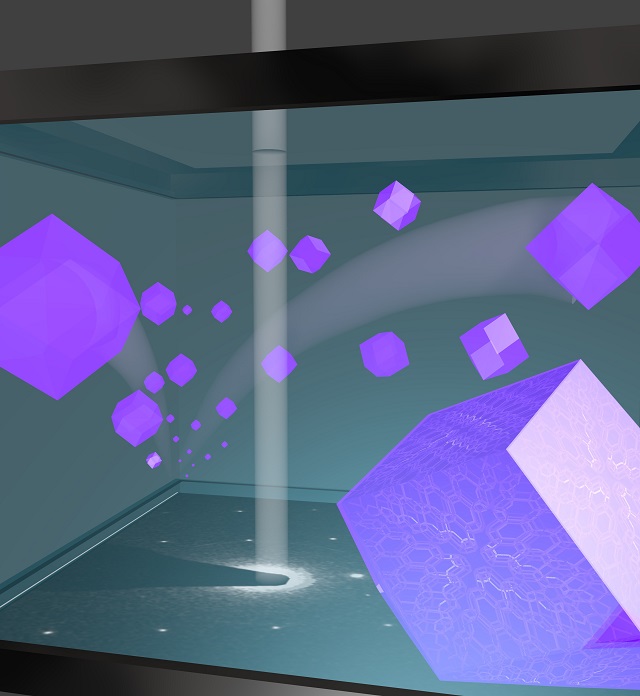Researchers have developed a new technique that helps in observing the growth of complex, self-assembled chemical nanostructures in real time. This latest breakthrough makes it possible to document nanoscale processes that occur in liquids down to one-billionth of a meter, and will also promote many future developments in nanotechnology.
The study was a collaborative effort of researchers from Florida State University, UC San Diego, and Pacific Northwest National Laboratory. It has been described in a paper published online in the Journal of the American Chemical Society.
 The UC San Diego chemists observed the growth of complex organic-inorganic hybrid materials in real time, providing an unprecedented understanding of their formation. Credit: Joseph Patterson, UC San Diego
The UC San Diego chemists observed the growth of complex organic-inorganic hybrid materials in real time, providing an unprecedented understanding of their formation. Credit: Joseph Patterson, UC San Diego
Both material scientists and chemists can apply this latest technique in their fundamental and applied studies to gain a better insight into the stepwise development of nanostructures. Previously, researchers used to study the modifications in nanostructures by taking screen shots of separate nanostructures through electron microscopy, or alternatively they used to observe the major changes in a large number of particles.
That process is like taking photos every 10 minutes of a football game and then trying to piece these photos together to tell the story of what is really a highly dynamic process. Until now, this was the state of the art in terms of how we could document how nanostructures formed. The development we describe in our paper demonstrates that these processes can be observed in real time, by literally videoing these processes on the nanoscale level using an electron microscope.
Nathan Gianneschi, an associate professor of chemistry and biochemistry at UC San Diego who led the study with the assistance of Seth Cohen, chair of UC San Diego’s Department of Chemistry and Biochemistry.
The latest development uses liquid cell transmission electron microscopy (liquid cell TEM or LCTEM), a newly developed process. Researchers often use the TEM technique to image nanoscale materials to better understand nanoscale objects. Although new developments in LCTEM have allowed researchers to observe the movements of nanoscale structures in liquids, the technique could not be used to image the growth of self-assembled chemical nanostructures in real time.
We showed for the first time that this technique can be used to observe the growth of complex organic-inorganic hybrid materials, providing an unprecedented understanding of their formation. This demonstration marks a significant step forward in LCTEM becoming essential for our understanding of nanoscale processes for all materials in liquids.
Gianneschi.
In order to simplify the process, the team first examined a chemical system, which is capable of assembling with a restricted number of parts and produces distinct materials. The research team included Michael Denny and Joseph Patterson from UC San Diego, Chiwoo Park from Florida State, and James Evans, Patricia Abellan, and Nigel Browning from Pacific Northwest National Laboratory. Patterson was the first author of the paper and performed the LCTEM at PNNL and UC San Diego along with Evans and Park. Park handled the video analysis, while Evans is adept in the technique.
We considered metal-organic frameworks to be the perfect starting point for this because they give ordered structures through an assembly process and include organic and inorganic components. The first step was to determine if these nanostructures would survive the experiment. This is necessary because materials are susceptible to being destroyed by the high energy electron beam that is used to image them. Once these conditions were established, we were then able to flow components into the TEM instrument, in solvent, and watch as the assembly process took place. This was made possible using a special sample cell holder for the TEM that allowed us to put liquids within a chamber, within the high vacuum instrument. We could then image through the chamber, to see what's inside.
Gianneschi
The researchers showed that the possibility of imaging such chemical complexes in real time demonstrates that the complicated processes of other fragile self-assemblies may be explained in a more profound way, such as viruses and chemicals that are biologically produced and many times smaller than bacteria.
This advance provides a tool for observing material as they assemble with resolutions only possible using electron microscopy. That is, length scales can be observed that are relevant to nanoscale materials and processes. In terms of imaging dynamics like this, we believe it will impact how nanotechnology is developed in the future, concluded Gianneschi.
The National Science Foundation, the Department of Energy’s Office of Basic Energy Sciences, and the Department of Defense funded the study.
References